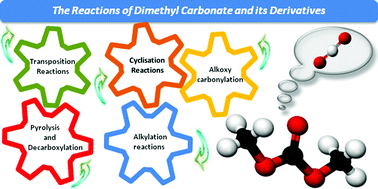当前位置:
X-MOL 学术
›
Green Chem.
›
论文详情
Our official English website, www.x-mol.net, welcomes your
feedback! (Note: you will need to create a separate account there.)
The reactions of dimethyl carbonate and its derivatives
Green Chemistry ( IF 9.3 ) Pub Date : 2017-10-30 00:00:00 , DOI: 10.1039/c7gc01764b P. Tundo 1, 2, 3, 4, 5 , M. Musolino 1, 2, 3, 4, 5 , F. Aricò 1, 2, 3, 4, 5
Green Chemistry ( IF 9.3 ) Pub Date : 2017-10-30 00:00:00 , DOI: 10.1039/c7gc01764b P. Tundo 1, 2, 3, 4, 5 , M. Musolino 1, 2, 3, 4, 5 , F. Aricò 1, 2, 3, 4, 5
Affiliation

|
The worldwide urge to embrace a sustainable and bio-compatible chemistry has led industry and academia to develop of chlorine-free methodologies focused on the use of CO2 and CO2-based compounds as feedstocks, promoters and reaction media. In this scenario, dialkyl carbonates (DACs) and in particular dimethyl carbonate (DMC) occupy a privileged position due to their low toxicity, high biodegradability and peculiar reactivity. Nowadays, the large-scale production of DACs is carried out through clean processes (i.e., phosgene-free processes), which include the direct insertion of CO2 into epoxides, allowing – in principle – recycling of the carbon dioxide emitted during carbonate degradation. This groundbreaking achievement has definitely drawn attention toward the conception of procedures to activate the rather stable DACs with the aim of employing these compounds as green alternatives to their reactive chlorinated analogues. DACs are ambident electrophiles, which under appropriate conditions can undergo BAc2- or BAl2-nucleophilic substitution to give, respectively, alkoxycarbonylation and alkylation reactions. The many efforts devoted to improving the industrial suitability of organic carbonates have unveiled an intriguing and innovative chemistry as demonstrated by the numerous publications and patents published on these compounds over the last thirty years. This review reports on DACs as alkoxycarbonylating agents and their applications in industry and fine synthesis, as well as alkylating agents including allylic alkylation using palladium catalysts and the Pd/Ti bimetallic system and anchimerically driven alkylations via mustard carbonates. Moreover, the reactivity of organic carbonates toward several substrates and under different reaction conditions is described along with some distinctive DAC-mediated cyclization and transposition reactions. The synthesis of olefins and ethers under both liquid and gas phase conditions via thermal decarboxylation of organic carbonates is also reported.
中文翻译:

碳酸二甲酯及其衍生物的反应
世界范围内对采用可持续的生物相容性化学的渴望促使工业界和学术界开发了无氯方法学,该方法致力于使用CO 2和基于CO 2的化合物作为原料,促进剂和反应介质。在这种情况下,碳酸二烷基酯(DAC),尤其是碳酸二甲酯(DMC)由于其低毒性,高生物降解性和特殊的反应性而占据着特权地位。如今,DAC的大规模生产是通过清洁工艺(即无光气工艺)进行的,其中包括直接插入CO 2转化为环氧化物,原则上可以回收碳酸盐降解过程中排放的二氧化碳。这一突破性的成就无疑引起了人们对激活相当稳定的DAC的程序概念的关注,目的是将这些化合物用作其反应性氯化类似物的绿色替代品。DAC是环境亲电体,在适当条件下会经历B Ac 2-或B Al2-亲核取代分别产生烷氧基羰基化和烷基化反应。致力于改善有机碳酸盐工业适应性的许多努力揭示了一种有趣的创新化学方法,最近三十年来有关这些化合物的大量出版物和专利对此进行了证明。这篇综述报道了作为烷氧基羰基化剂的DAC及其在工业和精细合成中的应用,以及烷基化剂,包括使用钯催化剂和Pd / Ti双金属体系的烯丙基烷基化,以及由Achimeric驱动的烷基化。芥末碳酸盐。此外,还描述了有机碳酸盐对几种底物和在不同反应条件下的反应性,以及一些独特的DAC介导的环化和转座反应。还报道了在液相和气相条件下通过有机碳酸酯的热脱羧合成烯烃和醚。
更新日期:2017-11-14
中文翻译:

碳酸二甲酯及其衍生物的反应
世界范围内对采用可持续的生物相容性化学的渴望促使工业界和学术界开发了无氯方法学,该方法致力于使用CO 2和基于CO 2的化合物作为原料,促进剂和反应介质。在这种情况下,碳酸二烷基酯(DAC),尤其是碳酸二甲酯(DMC)由于其低毒性,高生物降解性和特殊的反应性而占据着特权地位。如今,DAC的大规模生产是通过清洁工艺(即无光气工艺)进行的,其中包括直接插入CO 2转化为环氧化物,原则上可以回收碳酸盐降解过程中排放的二氧化碳。这一突破性的成就无疑引起了人们对激活相当稳定的DAC的程序概念的关注,目的是将这些化合物用作其反应性氯化类似物的绿色替代品。DAC是环境亲电体,在适当条件下会经历B Ac 2-或B Al2-亲核取代分别产生烷氧基羰基化和烷基化反应。致力于改善有机碳酸盐工业适应性的许多努力揭示了一种有趣的创新化学方法,最近三十年来有关这些化合物的大量出版物和专利对此进行了证明。这篇综述报道了作为烷氧基羰基化剂的DAC及其在工业和精细合成中的应用,以及烷基化剂,包括使用钯催化剂和Pd / Ti双金属体系的烯丙基烷基化,以及由Achimeric驱动的烷基化。芥末碳酸盐。此外,还描述了有机碳酸盐对几种底物和在不同反应条件下的反应性,以及一些独特的DAC介导的环化和转座反应。还报道了在液相和气相条件下通过有机碳酸酯的热脱羧合成烯烃和醚。









































 京公网安备 11010802027423号
京公网安备 11010802027423号